Parrots are fascinating and intelligent birds that have captivated humans for centuries. They are known for their colorful plumage, playful personalities, and impressive vocal abilities. But did you know that parrots also have some unique sleeping habits that differ from other animals?
In this article, we will explore how parrots sleep, why they sleep the way they do, and what their sleeping positions can reveal about their health and well-being. We will also provide some tips on how to create a comfortable and safe sleeping environment for your parrot.
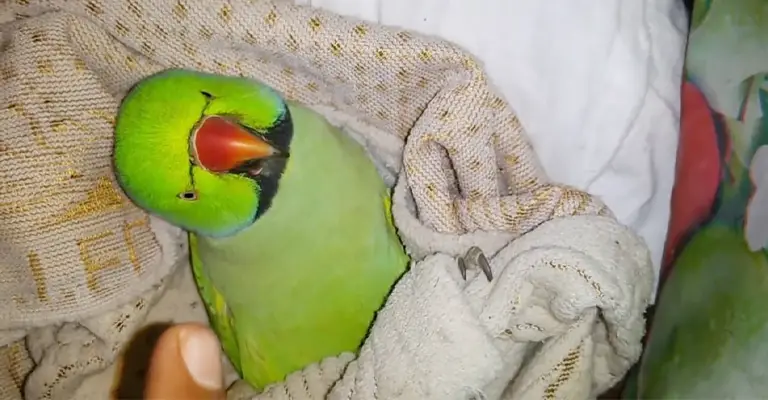
How Do Parrots Sleep?
Parrots, with their vibrant colors and incredible intelligence, are known for their unique sleep patterns. Understanding how these fascinating birds sleep can provide insights into their well-being and care. Here are nine reasons explaining how parrots sleep:
Perching
Parrots are natural perching birds who prefer to sleep while perched on a branch or a perch. Their strong feet and claws allow them to securely grip the surface, ensuring stability and safety while sleeping.
One-Legged Sleep
Parrots often sleep by tucking one leg up against their body while standing on the other leg. This posture helps conserve body heat and maintain balance during sleep.
Secure Environment
Parrots feel most comfortable and secure when they have a designated sleeping area or a cozy cage. Providing a quiet and peaceful space for them to sleep promotes restful and undisturbed sleep.
Nocturnal Rest
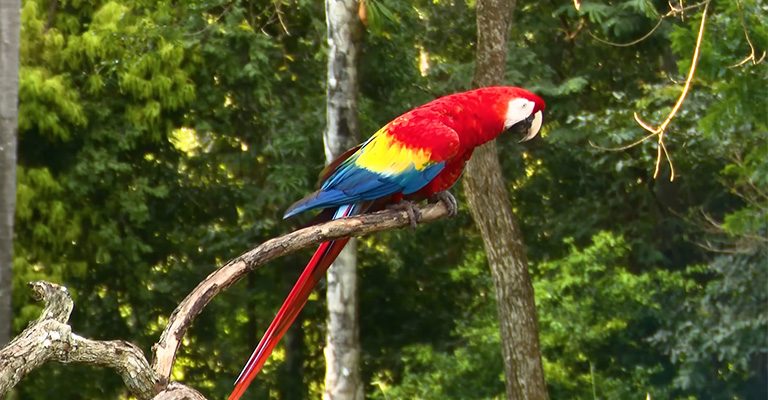
Parrots are diurnal creatures that are active during the day and sleep at night. However, they may have shorter periods of sleep during the day and engage in light napping.
Light Sleepers
Parrots have a keen sense of awareness even while sleeping. They are light sleepers, allowing them to quickly awaken and respond to potential threats or changes in their surroundings.
Covering Their Heads
Some parrots prefer to cover their heads or faces with their feathers or wings while sleeping. This behavior gives them a sense of security, blocking light and reducing sensory stimulation.
Quiet and Peaceful Environment
Parrots require a quiet and calm environment for optimal sleep. Loud noises or disturbances can disrupt their sleep patterns and cause stress. Providing a peaceful setting promotes deep and restorative sleep for these intelligent birds.
Group Sleep
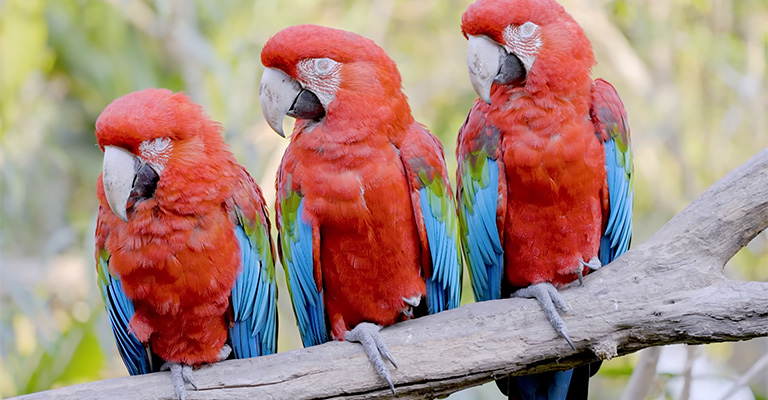
In the wild, some parrot species sleep in flocks or groups. Sleeping together provides them with a sense of safety and companionship. In captivity, parrots may exhibit similar behaviors, seeking comfort and security by sleeping close to their human caregivers or other birds.
REM Sleep
Parrots, like humans, experience REM (Rapid Eye Movement) sleep, associated with dreaming. During REM sleep, their eyes may twitch and make soft vocalizations or movements. This stage of sleep is essential for their overall well-being and cognitive function.
What Do Parrot Sleeping Positions Mean?
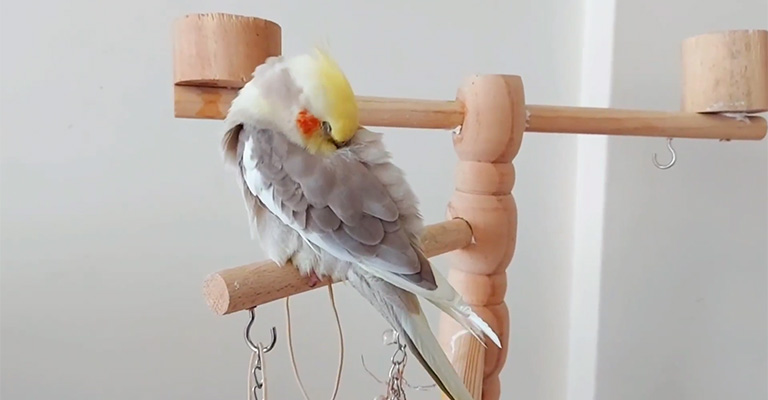
Parrot sleeping positions can reveal a lot about their health and well-being. By observing how your parrot sleeps, you can learn more about its personality, mood, comfort level, and possible health issues.
Here are some common parrot sleeping positions and what they mean:
Standing Position
Parrots may sleep while standing, particularly when they feel secure and comfortable in their environment. This position is common in wild parrots that roost on tree branches or other sturdy structures.
When standing, the parrot may rest one foot at a time, switching between each foot. Some parrots may even sleep with their beaks tucked into their backs, making them appear as if they are dozing off.
This position indicates that the parrot is relaxed and confident in its surroundings. It also shows that the parrot has good balance and coordination skills.
One-Leg Up
Parrots have a unique way of sleeping with one leg raised. They tend to tuck one leg up and hold it against their body while they sleep. This position is seen in parrots that prefer to perch on branches or other structures, as it helps them to balance their weight while sleeping.
Depending on the bird’s preference, the raised leg may be tucked under the body or held out to the side.
This position indicates that the parrot is comfortable and warm while sleeping. It also shows that the parrot has strong and flexible legs.
Both Legs Tucked Under the Body
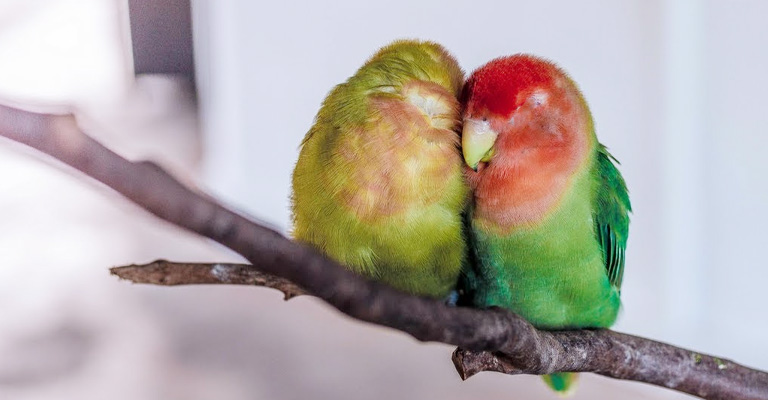
In this position, the parrot tucks both legs under its body and rests its weight on its belly. This is a common position for birds that prefer sleeping in a nest or enclosed space. This position is also common in parrots that prefer to sleep on their backs, as it allows them to rest comfortably while keeping their body warm.
This position indicates that the parrot is cozy and snug while sleeping. It also shows that the parrot has a soft and fluffy belly.
Perching with Head Tucked Under the Wing
Parrots may also sleep by perching on a branch or other structure with their head tucked under their wing. This position allows them to rest their neck muscles and provides a sense of security while they sleep.
Some parrots may even wrap their wings around their body while sleeping, creating a warm and comfortable environment.
This position indicates that the parrot is tired and sleepy. It also shows that the parrot has a long and flexible neck.
Perching with Head Resting on Back
Parrots may also sleep by perching on a branch or other structure with their head resting on their back. This position allows them to relax their head and neck while sleeping.
Some parrots may also extend their wings slightly while sleeping, creating a balance between warmth and ventilation.
This position indicates that the parrot is calm and peaceful while sleeping. It also shows that the parrot has a smooth and sleek back.
Perching with One Eye Closed
Parrots may also sleep by perching on a branch or other structure with one eye closed. This position allows them to monitor their environment for potential threats while still getting some rest.
Some parrots may also tilt their head slightly while sleeping, creating a better view of their surroundings.
This position indicates that the parrot is alert while sleeping. It also shows that the parrot has good vision and awareness skills.
Perching with Both Eyes Closed
Parrots may also sleep by perching on a branch or other structure with both eyes closed. This position allows them to enter deep sleep and dream while sleeping.
Some parrots may also lower their head slightly while sleeping, creating a more comfortable posture.
This position indicates that the parrot is relaxed and trusting while sleeping. It also shows that the parrot has good sleep quality and mental health.
Hanging Upside Down
Parrots may also sleep by hanging upside down from a branch or other structure. This position allows them to stretch their muscles and joints while sleeping.
Some parrots may also curl their tail around the branch while sleeping, creating a more stable grip.
This position indicates that the parrot is adventurous and playful while sleeping. It also shows that the parrot has strong and agile muscles and joints.
Lying Down
Parrots may also sleep by lying down on a flat surface, such as the bottom of the cage or a soft mat. This position allows them to rest their entire body while sleeping.
Some parrots may also spread their wings or legs while sleeping, creating a more relaxed posture.
This position indicates that the parrot is comfortable and confident while sleeping. It also shows that the parrot has good bone health and posture.
Sleeping in a Nest or Tent
Parrots may also sleep in a nest or tent, either made by themselves or provided by their owners. This position allows them to create a cozy and secure space for themselves while sleeping.
Some parrots may also decorate their nest or tent with feathers, toys, or other items, creating a more personalized environment.
This position indicates that the parrot is creative and territorial while sleeping. It also shows that the parrot has good nesting instincts and preferences.
FAQs
Parrots need about 10 to 12 hours of sleep per day to stay healthy and happy. However, they may not get all of their sleep at once. Instead, they may nap for a few minutes or hours during the day, and then sleep for longer periods at night.
You can tell if your parrot is sleeping well by observing its sleeping position, behavior, and mood. A well-rested parrot will sleep in a comfortable and secure position, such as standing on one leg, perching with its head tucked under the wing, or lying down. A well-rested parrot will also be alert, active, and cheerful during the day.
Some signs of sleep problems in parrots include sleeping too much or too little, sleeping in unusual or uncomfortable positions, sleeping at the wrong time of the day, being irritable, aggressive, or depressed, having feather plucking or other behavioral issues, having poor appetite or digestion, having low immunity or frequent infections.
Some causes of sleep problems in parrots include stress, boredom, loneliness, fear, anxiety, pain, illness, injury, hormonal changes, poor diet, lack of exercise, and environmental factors, such as noise, light, temperature, humidity, or air quality.
You can help your parrot sleep better by creating a comfortable and safe sleeping environment for it. You can also follow a consistent daily routine for your parrot, provide it with enough mental and physical stimulation during the day, avoid disturbing it during its sleep time, and consult a veterinarian if you notice any signs of sleep problems or other health issues.
Conclusion
Parrots are amazing birds that have some unique sleeping habits that differ from other animals. Parrots have a polyphasic sleep pattern, meaning they sleep in multiple short bursts throughout the day and night.
Parrots also have different sleep cycles and stages than humans. Parrots have a variety of sleeping positions that can reveal their health and well-being.
To help your parrot get enough sleep and stay healthy and happy, you need to create a comfortable and safe sleeping environment for it. You also need to monitor its sleeping position, behavior, and mood.
If you notice any signs of sleep problems or other health issues in your parrot, you should seek professional help as soon as possible. By understanding how parrots sleep and what their sleeping positions mean, you can better care for your feathered friend and enjoy a stronger bond with it.